 UK Royal Navy: 23 (86 total) ships.
UK Royal Navy: 23 (86 total) ships.WW2 British Destroyers:
V class | W class | W mod class | Shakespeare class (1917) | Scott class (1818) | A/B class (1926) | C/D class (1931) | E/F class (1933) | G/H class (1935) | I class (1936) | Tribal class (1937) | J/K/N class (1938) | L/M class (1940) | Hunt class DE (1939) | O/P class (1942) | Q/R class (1942) | S/T/U/V/W class (1942) | Z/ca class (1943) | Ch/Co/Cr class (1944) | Battle class (1945) | Weapon class (1945)Hunt Type I class DE (1939) | Hunt Type I class DE (1939) | Hunt Type I class DE (1939) | Hunt Type I class DE (1939) | Captain class DE (1941)
The Hunt class were escort destroyer of the Royal Navy, with first vessels ordered early in 1939 specifically to taking on escort roles and free resgular destroyer for fleet work. The very first serie, seen here, was a famous design disaster in which stablilitary calculations proved totally wrong. A serie of 23 ships followed for the Serie I, and four more until 1944. They also inspired the 500+ US destroyer escort classes that followed. The Hunt saw extensive service on the British east coast and Mediterranean as intended. They were named after British hunting domains across Britain. Few were sunk in action: HMS Exmoor, Quorn, and Tynedale, with the particular case of HMS Mendip, resold postwar to Egypt as Ibrahim el Awal, captured and sunk as target by the Israeli as Haifa testing its Gabriel missile.
Development
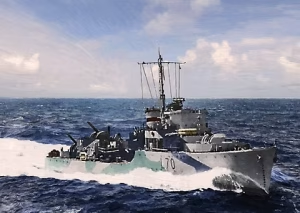 The Royal Navy identified the need for two types of destroyer before the war, in 1937-38 larger vessels with heavy artillery and torpedo armament for fleet work (like the Tribals) and another type for escort duties, which could be slower and more lightly armed, notably with less torpedoes. The construction of new ships was decided to replace the now aging V-W destroyers of 1918-19, which were all converted later in 1940 as convoy escorts.
The Royal Navy identified the need for two types of destroyer before the war, in 1937-38 larger vessels with heavy artillery and torpedo armament for fleet work (like the Tribals) and another type for escort duties, which could be slower and more lightly armed, notably with less torpedoes. The construction of new ships was decided to replace the now aging V-W destroyers of 1918-19, which were all converted later in 1940 as convoy escorts.
Indeed, old fleet destroyers could perform escort work, they were ill-suited from the get go as too fast and heavily armed in torpedoes, while having a lass capable ASW suite than tailored vessels for the task. The conversion was planned in case of war, but would take time. Contingency Plans has been prepared for the task also, leading to the design of corvettes to be built from civilian yards as an extreme measure (the Flower class). So in the meantime, a new class of destroyer escort was to be designed and built in military yards.
So new constructions were needed, and the design requireents were well understood as fleet destroyers were designed for speed, their machinery was judged inefficient at convoy speeds anf their range negatively affected by the way they operated in and out of the convoy. Their shape also, was made for speed again, but they performed poorly in heavy weather at lower speed, they were in general poor sea boats, with a lack of stability exacerbated by their additional equipment. The old V-W needed deep modifications and will be still unsufficient for the task, while brand new hull would be required with a proper hull and proper machinery, proper armament for escort work only.

ON BOARD THE SUBMARINE DEPOT SHIP HMS ADAMANT ON CONVOY. 28 MARCH 1942, AT SEA IN THE ATLANTIC. HMS ADAMANT AND ESCORTING WARSHIPS IN ONE OF THE LARGEST CONVOYS OF THE WAR, SAILING FROM THE CLYDE TO FREETOWN CARRYING SUPPLIES AND PERSONNEL FOR THE FORCES. The Hunt class destroyer HMS ALDENHAM, one of the escorting destroyers. Creator: Roper, F G (Lt). Source: © IWM (A 8436)
The naval staff still however wanted them “not too slow” and capable of 20+ knots burst to catch U-Boats in and out of the convor and be able to return to the convoy at any moment, meaning they had to overcame it fast. Convoy speed was established at 10 knots in WWI, updated to 12 knots in WW2, so a speed of 20 knots seems adequate. It was also envisons to used triple expansion or diesel machinery as well to spare more strategic steam turbines for fleet ships.
But the Hunt class in their early development preiod were still victim of contraditions among senior officers part of the table, as same wanted them to still be able to defend the convoy against other threats tha U-Boat, notably Gerùan destroyers, so they insisted on a heavy armament and torpedoes. For the speed they wanted still them to perform some fleet task as well, but the other faction insisted of a simplified, small type to reduce unit cost and better suit mass production under a British naval indutry un der heavy strain in manpower and resources. The project was dubbed the “fast escort vessel”, reflecting the views of the “fleet faction”, but was later classified as an “escort destroyer”.
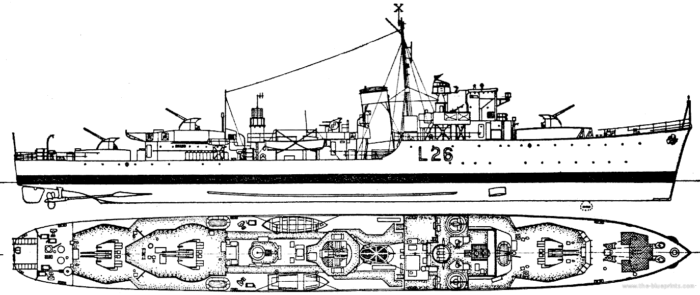
Orp Slazak of the Hunt Type II. This is the planned appearance of the Type I if design without error. The Type I had their aft turret removed, pompom position swapped in place and structures cut out.
The Hunt class were infamous for their design mishaps early in their design. In their genesis were originally designed for six 4in guns (and this number were issued for Atherstone, Fernie and Hambledon), but it was found that the first ship was dangerously unstable and that a serious error had been made 1n the calculations. They were accordingly ballasted and 2—4in removed. Denny fin stabilisers were a feature of this class, but these, though reducing the roll, gave a quick jerky motion.
All except Exmoor and possibly Tynedale had 2pdr pompom added against E-boats, usually as a bow chaser. In 1945 Meynell had the quadruple pompom replaced by a twin biaxial Bofors, and the armament of the class included two 20mm. The DC outfit was 50. All were laid down in 1939 and completed in 1940-41. Of the losses, Berkeley was bombed, and Exmoor torpedoed by an E-boat, Tynedale by a U-boat and Quorn by a Marder. When sold, Cottesmore was renamed Ibrahim el Awal, Mendip became Lin Fu, and Meynell and Quantock became Presidente Velasco Ibarra and Presidente Alfaro respectively.
Construction and Evolution

Hunt Type III HMS Aldenham (L22) with her quirky Mediterranean march 1942 camouflage
When construction was at last decided, a hunded ships was ordered and in the end, eighty-six Hunts were completed, of which 72 commissioned into the Royal Navy, the remaining 14 transferred to allied navies also partaking in escort work in the Atlantic: Bolebrooke, Border, Catterick, Hatherleigh, Modbury, Bramham and Hursley to the Greek Royal Hellenic Navy, Bedale, Oakley (i) and Silverton to the Free Polish Navy, Glaisdale, Eskdale and Badsworth to the Royal Norwegian Navy and Haldon to the Free French Navy.
After the issues of the first design was solved, the next series II and III proved more satisfying. However construction was stopped in late 1942 as enough escorts were now on their way, the way cheaper and better suited River class frigates and their successors, all built to naval standards in civilian yards.
The last two Hunts came from an independent lineage and were built to a private design that had been prepared pre-war by John I. Thornycroft & Company. Submitted to the Admiralty and rejected in 1938, a modified design had been accepted in 1940. They were known as the Type IV. They had a novel hull design, with a U-shaped forward section with a distinctive double knuckle and a full centre section with a square turn at the bilge. This form was intended to increase low-speed efficiency and reduce rolling without the need for ballast or stabilisers to improve the ships as gun platforms; testing showed an 8% increase in steaming efficiency at 20 knots (37 km/h) for a 2% loss full ahead.
Other features included a long fo’c’sle stretching for most of the length of the ship, which increased internal accommodation space (the lack of which was a perennial problem in wartime ships with enlarged crews) and allowed the crew to fight the ship almost completely under cover. ‘X’ gun was now at the fo’c’sle deck level rather than on a raised shelter deck. The design was large enough to carry a triple set of torpedoes but as they too were at fo’c’sle deck level the training apparatus had to be remotely mounted a deck below.
Design of the class
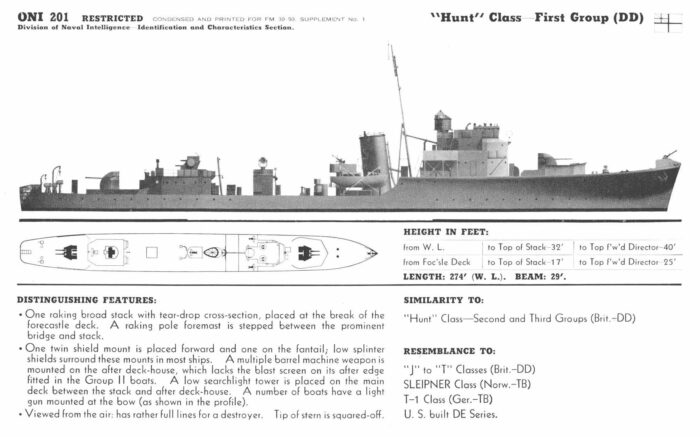
ONI depiction of the Hunt class Type I
The Hunt class to gain time, were not design from scrath, but modelled on the 1938 escort sloop Bittern. This was a 262-foot (80 m) ship rated for 1,190 tons. Her geared steam turbines were rated for 3,300 shp (2,500 kW), which was enough for a top speed of 18.75 kn (34.73 km/h; 21.58 mph). They had an armament of three twin Mark XIX mounts all given the QF 4-inch (102 mm) gun Mark XVI. The “six gun faction” indeed was eventually convinced to lower expectation out of stability calculation realism, as showed by the fate of the first ship.
These four guns were not a disadvantage as they were controlled by a Fuze Keeping Clock AA fire control computer, enabling them to engage aircraft if needed, making them versatile, useful AA/S and ASW escorts.
The Hunt class were eventually agreed upon to have the same armament, plus a quadruple QF 2-pounder mount Mark VIIforcloser AA defence. The hull was of the same length, but the beam was lowered to 8 feet (2 m) to try and achieve a greater speed at the same output. The envisioned output was indeed raised to 19,000 shp (14,000 kW) for 27 knots (50 km/h), a massive increase from 19 knots. The first twenty ships were ordered in March and April 1939, all constructed to Admiralty standards as destroyers and unlike later frigates, but they were associated with a daunting design challenge. Too short and narrow, and with an insufficient range for open ocean work (typically the Atlantic) they would be restricted to North Sea and Mediterranean escort, which was traded to meet requirements of armament and speed. These demanding specifications in an overworked Admiralty design department led to an oversight, in fact a major design miscalculation. When detailed calculations were done, the centre of gravity was higher than expected so the beam was increased again.
The first ships after completion showed to be overweight by 70 tons and resolutely top-heavy, unstable to a dangerous level. The first twenty ships however were too far advanced in construction when it was realized and compensatory measures were taken, removing the ‘X’ 4-inch gun mount (so back to three guns), cutting down the bridge and adding 50 tons of permanent additional ballast. The Type I group which is the subject here also had their 2-pounder guns relocated from behind the funnel to ‘X’ position after the removal of the main gun. Not happy to have relinquishe the torpedo tubes, some in the naval staff were even less happy when a main gun was removed. But in truth, this armament was almost an overkill for surfaced U-Boat, it was good enough against possible Luftwaffe attack, but woefully weak against Kreigsmarine destroyer.
The Type I design deficiencies were resvolved in a radical way, splitting the hulls lengthwise, adding a 2½ foot section to make for a beam up to 31 ft 6 in. So the margin of stability for the Type II group, which also had a lower and redesigned bridge with a compass platform extended forward to the wheelhouse face and the intended three twin mounts. Under the 1939 Emergency War Programme, 36 more were ordered, making for 33 ships of Type II, and 28 of Type III before construction was halted to free some capacity in Naval yards for repairs and other fleet ships. The Depth charge stowage was also augmented significantly from 40 to 110.
As per the 1940 building programme, torpedoes were to be reintegrated on the 27 of the Type III group intended for the Mediterranean with the ‘Y’ gun removed for a twin 21-inch torpedo tube bank amidships, and the searchlight displaced to the aft shelter deck. The Type III had also a straight capped funnel and a straight, unraked foremast. Fourteen had stabiliser fins not fitted or removed with the space used for extra fuel oil. Still, some wanted more torpedo armament and Thornycroft proposed a larger, alternative design with a longer forecastle and triple torpedo tube bank. The ships were named Brecon and Byssenden, but remained the only ones in the Type IV. In betwee, te Royal Navy received scores of US-built escorts, under leand lease, essentially modified Hunt class giving the “Captain class”.
Hull and general design
The Hunt class Type I had a symbolic 1,000 long tons (1,020 t) standard, and reached 1,340 long tons (1,360 t) when fully loaded, for an overall length of 85 m (278 ft 10 in) and a beam initially of 8.8 m (28 ft 10 in), a draught of 3.27 m (10 ft 9 in). The design was partly inspired by the sloop HMS Bittern, but significantly altered for better ASW work, notably with a beefier ASW depth charge armament, tall bridge, and long structure uninterrupted by torpedo tubes. Both the mast and single funnel were raked. The original bridge combined an enclose navigation and a spotting bridge atop. The navigation bridge originally had to clear out the forward twin mount.
The superstructure was extended all the way to the aft twin guns in superfuring positions originally. The hull ended with a round stern, and had in proportion a forecastle that was longer than for conventional destroyers and ended almost admiship. The stem was angled less than Tribal class destroyer, and more than traditional destroyers like the G-H-I class. There was a reasonable amount of sheer, and a sloped section forward to raise the bow for extra seaworthiness. The ships only carried two utility boats, one on either side of the funnel as was the usual practice. The main
Powerplant
Propulsion-wise, it was quickly ruled out the possibility of having diesels or VTE engines, to reach 20 knots. Turbines were the only solution, albeit smaller and designed to procured the require top speed in exceptional condutions and still make good of heigh-pressure/low-pressure to optimize consumption and increase range. The final result was the adoption of two small shaft Parsons geared turbines of a more economical types and yet rated for 19,000 shp (14,170 kW). They were fed by two Admiralty 3-drum boilers working at a pressure of ??? (in research).
This made up for a top speed of 27.5 knots (31.6 mph; 50.9 km/h), but generally a more practical 26 knots (29.9 mph; 48.2 km/h) to spare machinery and fuel oil. This was their optimal high speed indeed. The full Range was 3,500 nmi (6,500 km) at 15 knots (28 km/h), but at 26 knots they still can reach 1,000 nmi (1,850 km), showing the qualities of these turbines.
Armament
As said above, the Hunt class Type I were originally to be armed with six QF 4-inch (102 mm) Mark XVI guns on twin mounts Mk. XIX. Unfortunately calculation errors led to radical transformations, with the superstructure cut out and simplified, ballasts added, and the omission of “X” mount (uperfiring aft), for a final four main guns. Instead of “X” was located a quadrupled QF 2-pounder (40 mm) Mk. VIII “pompom” AA guns, on a quad mount MK.VII, which have it an excellent arc of fire, while being lighter than a twin mounts Mk. XIX.
This was completed by two 20 mm Oerlikon AA guns on single mounts P Mk. III. As for ASW armament, they had 40 depth charges, with 2 throwers, and a single 1 rack. This was not impressive compared to late River class frigates for example, but improved during the war, many fold.
QF 4-inch (102 mm) Mark XVI guns
The QF 4-inch Mark XVI gun (also written as QF 4-inch Mk XVI) was a British dual-purpose naval gun widely used by the Royal Navy and Commonwealth navies during and after World War II.
This Naval artillery was dual-purpose, anti-ship and anti-aircraft. After design modifications, notably by giving them a greater beam and reworked bridge, the Type II, III and IV all had three twin mounts.
Specs:
2,495 kg (barrel and breech), 4 inches (102 mm) caliber at 45 calibers (180 inches/4.57 m)
Shell weight: 35 lb (15.9 kg)
Rate of fire: 15–20 rounds per minute
Muzzle velocity: 2,660 ft/s (810 m/s)
Effective range: 18,150 yards (16,600 m) at 45° elevation
Maximum ceiling: 39,000 ft (11,900 m) against aircraft
Elevation range: -10° to +80°
Traverse: 360° on suitable mounts
Crew: 9 on average.
Mounts used: Twin mounts (Mark XIX), shielded (no fully enclose turret).
The Mk XVI was also used as standard secondary armament for many British and Commonwealth warships during WWII, notably the Canadian Tribal-class and J-K-N-class.
The twin HA/LA (High Angle/Low Angle) mounts Mark XIX were powered and allowed quick traverse and elevation, essential for anti-aircraft use. They director-controlled, especially on larger ships, integrating radar and fire-control systems, but not on the Hunt class due to weight issues.
QF 2-pounder (40 mm) Mk. VIII AA guns
The QF 2-pounder “pompom” was the emblematic British naval anti-aircraft (AA) autocannon of WW2 which needs no further introduction. It was seen virtually on all RN ships from the smallest coastal vessels to the largest aicraft carrier and battleship, declined into single, twin, quad and octuple mounts. On the Type I they replaced the “X” twin 4-in mount, being lighter and still having an excellent arc of fire to offer an almost unobstructed 360° coverage. It was tasked on the Hunt Type I of short- to medium-range air defense after the DP 4-in guns which were slower firing.
The Quadruple mount needed a crew of six, but can be limited to just 4 if needed.
The 40 mm (1.575 in) in latter models fired in Automatic mode with belts for no interruption at a rate of 240 rounds a min, but the usual rate was 115 rounds per minute per barrel at a practical rate with 14 or 28-round hopper-fed magazines.
Each shell weighted 2 lb (0.91 kg) — hence the name “2-pounder” at a Muzzle Velocity: 2,040 ft/s (622 m/s).
Effective Range was c3,800 meters (AA)/5,500 meters (surface)
It became less effective against faster aircraft as WWII progressed, leading to gradual replacement by Bofors 40 mm.
However it was active until 1945 as being reliable and easy to maintain, with a high rate of fire for its quadruple mount, but had a low velocity, limited hitting power and range compared to the Bofors with an accuracy and lethality diminished against high-speed aircraft in 1944-45.
20 mm Oerlikon AA guns
The 20 mm Oerlikon anti-aircraft (AA) gun needs no presentation. It was was one of the most widely used light automatic cannons during World War II, a staple on Allied warships, merchant vessels, and land-based platforms due to its simplicity, reliability, and effectiveness at close-range air defense. However it was not present of course in the original design, only installed with moderniations in 1942-43.
The 20 mm (0.787 in) Automatic anti-aircraft gun was Blowback-operated (open bolt) and fed by 60-round drum magazine (top-mounted), needed only a single gunner and a couple of loaders/spotters. Simple, robust, light, compact, it could be operated by minimally trained crews and placed on tight spot on a ship. The Hunt class were given two single Mk II/IV models at first.
Performance:
Muzzle Velocity: 830 m/s (2,723 ft/s), with 123 g (High-Explosive) shells.
Rate of Fire: ~250–320 rounds/min (cyclic)
Effective Range: 1,000–1,500 m (air targets), 4,800 m surface
The Single mount was manually aimed with shoulder supports and ring sights. Its mount included walls lined internally with ammunition holders, but full cheesebox magazines were carried frm a secured, armoured locker by the loaders. It became the shorter ranges AA defensive layer on the Hunt class, but they only carried two in their career.
depth charges
The Hunt class were given a single Roll-off depth charge rack art the stern at first (capacity ten DCs) and just two depht charge projectors (Y-Gun) for a global provision of 30 depht charges, all located at the stern. This was good enough for a single or two attack per mission and judged quickly inadequate as the war progressed, but this provision was in part dictacted by weight constraints.
Standard Mark VII: Entered service in 1939, weighted 420 lbs. (191 kg) and carried 290 lbs. (132 kg) TNT with a sink Rate or Terminal Velocity of 9.9 fps (3.0 mps) with a max setting at 300 feet (91 m) later 500 feet (182 m).
Mark X (introduced 1944) and Mark X*, data to come for latter versions.
The depht charge load was raised to 50 (20 more) in 1941-42, but not raised further. In comparison, the Flower class corvettes and River class Frigates carried way more, including up to eight depht charge thrower.
Sensors
Type 285 radar
25 kW Gunnery radar for surface and AA ranging, coupled with the twin 4-in HA mounts.
Frequency 600 MHz, Beamwidth 18° (horizontal) 43° (vertical). Pulsewidth 2 μs
Range 18,000 yd (16,000 m), Altitude 15,000 ft (4,600 m), Precision 150 yd (140 m)
Power
Type 286 radar
6 kW surface radar operating in VHF-band British naval air search radar, available since 1940. Designed for small ships and without rotating antenna (the ship needed to be swayed to focus the beam). Replaced by Type 291. frequency 214 MHz, pulse repetition frequency (PRF) 200 to 800 Hz, pulsewidth (τ) 2 µs. Range 25 nl (46 km).
Type 271 radar
5-70 kW Surface search radar introduced in 1941, with a naval microwave-frequency system, small antenna (28 in (0.71 m)) but with improved resolution to pick up a surfaced U-boat at 3 miles (4.8 km) or even a periscope at 900 yards (820 m), very useful by night. Frequency 2950 at 50 MHz (S-band), PRF 500 pps.
Beamwidth 8.6º horizontal, 85º vertical, pulsewidth 1.5 μs, 2 rpm. Range 1-11 NM (1.9–20.4 km). Azimuth 220-360º accuracy ~2º, 250 yards range.
Type 128 sonar
Typical British destroyer sonar, retractable, installed from 1937, last prewar set. Equipped with a range recorder and controlled from the bridge if needed.
Appearance
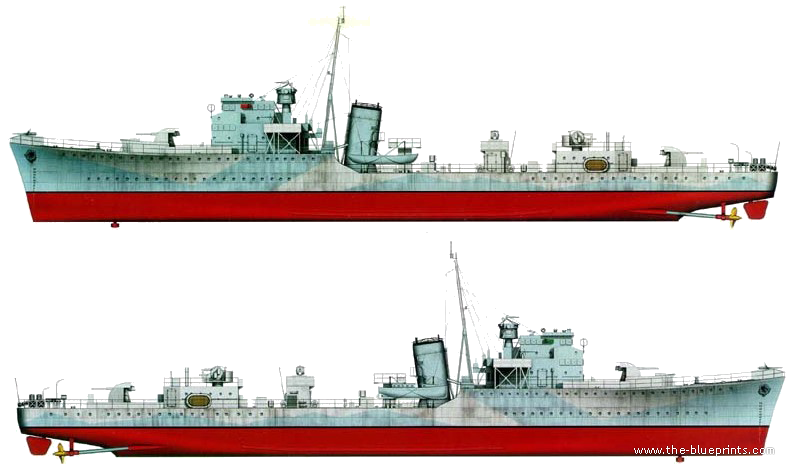
Rendition of the Hunt Type I HMS Fernie in 1943.
The Hunt class camouflage was a mix of the usual western approach patterns of base light gray, light blue, dark blue mostly in straight shapes. The same as for the River class frigates, especially in 1942-43. In 1940 as they entered service, the usual pattern was medium gray for the hull, lighter structures, and a fake wave painted at the bow creating the illusion of a greater speed to break target calculation accuracy by submariners.
⚙ specifications |
|
| Displacement | 1,000 long tons (1,020 t) standard, 1,340 long tons (1,360 t) full load |
| Dimensions | 85 x 8.8 x 3.27m (278 ft 10 in x 28 ft 10 in x 10 ft 9 in) |
| Propulsion | 2 shaft Parsons geared turbines, 2 Admiralty 3-drum boilers, 19,000 shp (14,170 kW) |
| Speed | 27.5 knots (31.6 mph; 50.9 km/h) top, 26 kn (29.9 mph; 48.2 km/h) average. |
| Range | 3,500 nmi (6,500 km) at 15 kn (28 km/h) |
| Armament | 2×2 QF 4-inch Mark XVI guns, 1×4 QF 2-pdr pompom Mk. VIII, 30 DCS (2 DCT, 1 DCR) |
| Protection | Usual ASW compartmentation |
| Sensors | See notes (from 1942) |
| Crew | 146 |
Modifications of the Hunt class
In 1940, Atherstone, Fernie and Hambledon were the first to have their “X” twin 4-in mount removed. It was omitted at completion by all the others.
In 1941, almost all received a type 285 and type 286 radars. Until late 1942 when they received maintenance, they also had two 20mm/70 Oerlikon Mk II/IV installed and their DC stowage increased up to 50.
In 1942, HMS Atherstone, Berkeley, Blencathra, Cattistock, Cleveland, Cotswold, Cottesmore, Eglinton, Fernie, Garth, Hambledon, Holderness, Liddesdale, Mendip, Meynell, Pytchley, Quantock, Quorn, Southdown, Whaddon swo the additon of a single extra 40mm/39 2pdr QF Mk VIII.
In 1943, their type 286 radar was replaced when available by the new type 291 radar and some also obtained a type 271 radar.
In 1945, HMS Meynell ended the war with a unusual combo of her quad 40mm/39 pompom and a twin 40mm/56 Bofors Mk XI.
Other ships ended the war with a combo radars including two 20mm/70 Mk III AA guns and the type 271 (for some), type 285, type 286 radars and type 128 sonar. HMS Meynell postwar had its pompom replaced by a twin 40mm/60 Bofors RP.50 Mk V, single 40mm/39 Mk VIII pompom, her two Oerlikon AA guns.
The Hunt class in operation
Hunt class Career
 HMS Atherstone (1939)
HMS Atherstone (1939)
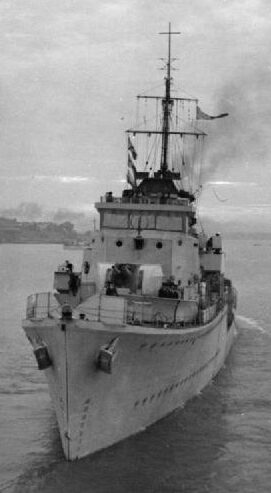 The lead ship of the class was ordered to Cammell Laird, Birkenhead and laid down on 8 June 1939. She was launched on 12 December 1939 and completed on 23 March 1940. Before completion, in 1939, an inclining test when fitting out, showed that she was dangerously unstable. Which led to an enquiry and discovering a blatant design error. To restore stability to minimally acceptable levels, the “X” twin 4 inch mount was removed, the superstructure and funnel cut down, additional ballast fitted. Atherstone was completed a bit later than planned, commissioned with the pennant number L05 on 23 March 1940 instead of February. After initial trials, she joined the 1st Destroyer Flotilla at Portsmouth and used for channel convoy escort. This summer she was esceptionally detached to the Home Fleet, and was back to Portsmouth in August. On 11 September 1940 with Convoy CW11 in the Channel, there was a Luftwaffe attack in which she took two light bombs hits (likely 50 kg) and near missed by a third. There was serious damage and she lost 5 men. She had repair at Chatham and returned to the 1st DF in January 1941, resuming convoy escort in the Channel. By December 1941 she was refitted at Southampton, and joined afterwards the 15th DF at Devonport.
The lead ship of the class was ordered to Cammell Laird, Birkenhead and laid down on 8 June 1939. She was launched on 12 December 1939 and completed on 23 March 1940. Before completion, in 1939, an inclining test when fitting out, showed that she was dangerously unstable. Which led to an enquiry and discovering a blatant design error. To restore stability to minimally acceptable levels, the “X” twin 4 inch mount was removed, the superstructure and funnel cut down, additional ballast fitted. Atherstone was completed a bit later than planned, commissioned with the pennant number L05 on 23 March 1940 instead of February. After initial trials, she joined the 1st Destroyer Flotilla at Portsmouth and used for channel convoy escort. This summer she was esceptionally detached to the Home Fleet, and was back to Portsmouth in August. On 11 September 1940 with Convoy CW11 in the Channel, there was a Luftwaffe attack in which she took two light bombs hits (likely 50 kg) and near missed by a third. There was serious damage and she lost 5 men. She had repair at Chatham and returned to the 1st DF in January 1941, resuming convoy escort in the Channel. By December 1941 she was refitted at Southampton, and joined afterwards the 15th DF at Devonport.
On 26 March 1942 she took part in Operation Chariot, the daring St Nazaire Raid. She escorted the Campbeltown, festooned with TN?T to blast the Normandie dock gates, making it unusuable for Kriegsmarine’s capital ships, notably Bismarck. She also towed MGB 314 on the passage to St Nazaire and on 27 March her sister Tynedale sighted U-593, the two escort destroyers attacked ahd keep “her head down”, preventing her from interfering with the raid.
In May 1942n Atherstone was transferred to the 16th DF, escorting convoys off the East coast and by March 1943 she was transferred to the Mediterranean, 18th DF. In July 1943, she was in Operation Husky, the invasion of Sicily, part of British XXX Corps, SW of Syracuse. In September 1943 she was in Operation Avalanche, escorting aircraft carriers providing air cover.
On 26 November 1943 she rescued 70 survivors from troopship HMT Rohna (hit and sunk by a Henschel Hs 293 glide bomb off French Algeria). In August 1944, she escorted convoys to the beaches for Operation Dragoon. In November 1944, she was in the 5th Df at Alexandria, Adriatic Sea. On 9 December with the DD Aldenham she shelled German troops on the island of Rab. On 14 December 1944 they did the same on Pag. However while back, Aldenham struck a mine and sank 45 nmi (52 mi; 83 km) SE of Pola and Atherstone picked up 63 survivors. On 23 September 1945 she was back home, paid off into reserve, Portsmouth until 1953, transferred to Cardiff, extended reserve and stricken on 23 November 1957, BU on Glasgow’s Smith & Houston.
 HMS Berkeley
HMS Berkeley
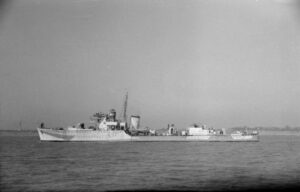 Named after on the the Glucestershire fox hunt mantions, she was ordered to Cammell Laird, Birkenhead, laid down on 8 June 1939 and launched on 29 January 1940, completed on 6 June 1940 after many modifications. Her work up was interrupted to take part Operation Aerial, the later evacuation of the remnants of the British Expeditionary Force from western France. She notably ferried senior naval officers to St Nazaire and Bordeaux, notably as radio link to Paul Reynaud and the French government. After French fell she evacuated the British embassy staff and Władysław Raczkiewicz and his Polish and Czech troops.
Named after on the the Glucestershire fox hunt mantions, she was ordered to Cammell Laird, Birkenhead, laid down on 8 June 1939 and launched on 29 January 1940, completed on 6 June 1940 after many modifications. Her work up was interrupted to take part Operation Aerial, the later evacuation of the remnants of the British Expeditionary Force from western France. She notably ferried senior naval officers to St Nazaire and Bordeaux, notably as radio link to Paul Reynaud and the French government. After French fell she evacuated the British embassy staff and Władysław Raczkiewicz and his Polish and Czech troops.
After full completion of work up, she was assigned to the 1st DF at Portsmouth, for channel convoy escort and North Sea. In August 1940 she escorted minelayers for Operation SN32. On 8/9 September 1940 with Atherstone, Beagle, Bulldog and Fernie she made a sweep between French coast, Le Touquet and Cap d’Antifer as German invasion shipping was signalled, but no contact made. On 20 December she had a magnetic mine exploding 30 yd (27 m) off her port side in the outer Medway, repaired at Chatham.
Next she resumed convoy escort duties in January 1941. On 22 February, she escorted HMS Icarus for minelaying Operation JK and resumed escorting convoys. She was part of the failed interception in the “Channel Dash”. She trained with older DDs of the 15th and 21st DF for this, but sent back to port, lacking torpedoes.
Lt. James Yorke took command on 27 March 1942. She was in escort until July 1942, and selected for Operation Jubilee the Dieppr raid, carried out on 19 August 1942, screening the landing forces and providing gunfire support with little effectiveness. After the force withdre she was attack by Fw 190s from Jagdgeschwader 2 armed with bombs. On broke her back and she lst 16 crew and many Canadians, picked up from a landing craft, but damage was beyond control, so she was abandoned, scuttled by torpedoes from Albrighton and sank.
 HMS Cattistock
HMS Cattistock
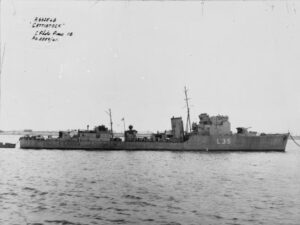 HMS Cattistock was built at Yarrow, Scotstoun, laid down on 9 June 1939, launched on 22 February 1940 and completed on 22 July 1940. After commissioning she was used for the filming of the Admiralty’s Naval Instructional Film A63, “The Duties of the Helmsman” (1941). She was on convoy escort duties in the North Sea but detached for the shelling of Dieppe with HMS Quorn and HMS Mendip on 26 July 1941. In May 1944, she was in Force G for Operation Neptune (Operation Overlord). She escorted Convoy G1 with minesweepers off off Gold Beach and escorted Force K providing fire support in King Sector. She returned to convoy escort duties off Normandy and against E-boat attacks on July 1944. On 7 July she was lightly damaged in such engagement. She was refitted in Portsmouth for boiler tube replacemen and resumed patrol duties on 24 August. On the 29th she intercepted German naval forces fleeing Le Havre with HMS Retalick. This action saw her hit 26 times, under Lt. Richard Keddie, which was killed with four more in the bridge, and 25 men wounded. The severe damage fored her to Portsmouth for repairs (three months) after which she was back in escort duties. On 2 February 1945 she sunk a German midget submarine off Zeebrugge. In August 1945 she was transferred to the Portsmouth Local Flotilla, until paid off on 26 March 1946, sold for scrap in 1957. In June she was towed for BU to John Cashmore Ltd at Newport in Wales.
HMS Cattistock was built at Yarrow, Scotstoun, laid down on 9 June 1939, launched on 22 February 1940 and completed on 22 July 1940. After commissioning she was used for the filming of the Admiralty’s Naval Instructional Film A63, “The Duties of the Helmsman” (1941). She was on convoy escort duties in the North Sea but detached for the shelling of Dieppe with HMS Quorn and HMS Mendip on 26 July 1941. In May 1944, she was in Force G for Operation Neptune (Operation Overlord). She escorted Convoy G1 with minesweepers off off Gold Beach and escorted Force K providing fire support in King Sector. She returned to convoy escort duties off Normandy and against E-boat attacks on July 1944. On 7 July she was lightly damaged in such engagement. She was refitted in Portsmouth for boiler tube replacemen and resumed patrol duties on 24 August. On the 29th she intercepted German naval forces fleeing Le Havre with HMS Retalick. This action saw her hit 26 times, under Lt. Richard Keddie, which was killed with four more in the bridge, and 25 men wounded. The severe damage fored her to Portsmouth for repairs (three months) after which she was back in escort duties. On 2 February 1945 she sunk a German midget submarine off Zeebrugge. In August 1945 she was transferred to the Portsmouth Local Flotilla, until paid off on 26 March 1946, sold for scrap in 1957. In June she was towed for BU to John Cashmore Ltd at Newport in Wales.
 HMS Cotswold (L45, 1940)
HMS Cotswold (L45, 1940)
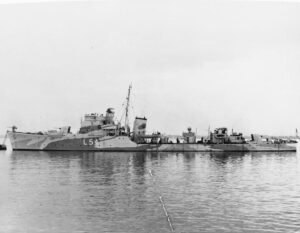 HMS Costwold was ordered at Yarrow, Scotstoun, laid down on 11 October 1939, launched: 18 July 1940, and completed on 16 November 1940. She was adopted and funded by the civil community of North Cotswold Urban District, Gloucestershire officialized at Warship Week in 1942. The fundraising was led by Clare Spurgin. She spent most her service with the North Sea in 1941–1945. In 1942 she struck a mine off Ordfordness, repaired in HM Dockyard in Chatham. In June 1944 she escort the landing force. Postwar she was transferred to the Reserve Fleet at Portsmouth from June 1946, and transferred to Harwich in 1958. She left the reserve to be put on the disposal list, sold to Thos. W. Ward and BU at Grays, Essex on 1 September 1957. Full logs
HMS Costwold was ordered at Yarrow, Scotstoun, laid down on 11 October 1939, launched: 18 July 1940, and completed on 16 November 1940. She was adopted and funded by the civil community of North Cotswold Urban District, Gloucestershire officialized at Warship Week in 1942. The fundraising was led by Clare Spurgin. She spent most her service with the North Sea in 1941–1945. In 1942 she struck a mine off Ordfordness, repaired in HM Dockyard in Chatham. In June 1944 she escort the landing force. Postwar she was transferred to the Reserve Fleet at Portsmouth from June 1946, and transferred to Harwich in 1958. She left the reserve to be put on the disposal list, sold to Thos. W. Ward and BU at Grays, Essex on 1 September 1957. Full logs
 HMS Cottesmore
HMS Cottesmore
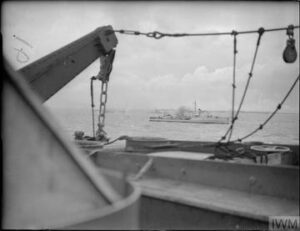
HMS Cottesmore was laid down at Yarrow Shipbuilders, Scotstoun on 12 December 1939, launched on 5 September 1940 and completed on 29 December 1940. Full Logs. She joined the 21st Destroyer Flotilla based at Sheerness,escorting convoys along the East coast, patrolling in support for minelaying operations and on 17 March 1941, with Cattistock and Vesper she escorted convoy FN.33, attacked by S-Boote off Lowestoft, but they were repelled.
On 12 March 1942, Scharnhorst and Gneisenau, Prinz Eugen left Brest in the “Channel Dash”. Cottesmore was in Sheerness but was too slow to intercept. On 28 July with HMS Calpe she engaged German patrol boats off Cap de la Hague. V 202 Hermann Bösch was sunk. On return they were attacked by the Luftwaffe, Cottesmore took light damaged, 3 wounded. On 13/14 October 1942 with Albrighton, Eskdale, Glaisdale and Quorn plus eight MTBs she was sent to intercept KMS Komet attempting to break out with an escort of four Type 35 and Type 37 torpedo boats. Komet was sunk with all hands off Cherbourg by MTB 236. On 6 June 1944, Cottesmore escorting minesweepers to Gold Beach and brought gunfire support and remained in support until August, patrolling agains flank attacks. By November 1944 with Garth she escorted the monitors HMS Erebus and Roberts bombarding Walcheren in Operation Infatuate.
She was placed in reserve at Devonport on 28 February 1946, Cat. C from January 1949 and on 20 April 1950 she was renamed Ibrahim El Awal on 17 July 1950 and was refitted at J. Samuel White shipyard, Cowes. She exchanged names with the Hunt-class Mohammed Ali el Kebir (former HMS Mendip) in 1951. In 1971 as “Port Said” she was rearmed with Soviet weapons and by 1986 was the last Hunt class in in service, becoming an accommodation hulk, scrapped in the 2000s.
 HMS Cleveland (1940)
HMS Cleveland (1940)
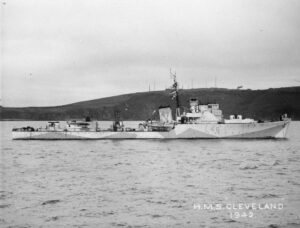 HMS Cleveland was ordered to Yarrow, Scotstoun, laid down on 7 July 1939 and launched on 24 April 1940. She was Completed on 18 September 1940. She completed work up in home waters in the North Sea and the Channel, as well as in 1941-1942. By April 1943 she was reassigned to the Mediterranean. She was in cover for the Allied landings in Italy Sicily, starting with Operation Husky, then at Salerno with Operation Avalanche. Later in 1944, she was deployed in the Mediterranean-Aegean Sea as the RN attempted to retake the islands from german occupation. On 29 September 1945, she left Gibraltar to Devonport and was placed in reserve until sold for scrap but wrecked at Llangennith beach, Gower Peninsula, Wales, on 28 June 1957. It happened while under tow to Llanelli. Her hull was stripped, blown up in December 1959 and followed a gradual salvage on Llangennith beach.
HMS Cleveland was ordered to Yarrow, Scotstoun, laid down on 7 July 1939 and launched on 24 April 1940. She was Completed on 18 September 1940. She completed work up in home waters in the North Sea and the Channel, as well as in 1941-1942. By April 1943 she was reassigned to the Mediterranean. She was in cover for the Allied landings in Italy Sicily, starting with Operation Husky, then at Salerno with Operation Avalanche. Later in 1944, she was deployed in the Mediterranean-Aegean Sea as the RN attempted to retake the islands from german occupation. On 29 September 1945, she left Gibraltar to Devonport and was placed in reserve until sold for scrap but wrecked at Llangennith beach, Gower Peninsula, Wales, on 28 June 1957. It happened while under tow to Llanelli. Her hull was stripped, blown up in December 1959 and followed a gradual salvage on Llangennith beach.
 HMS Eglinton (1939)
HMS Eglinton (1939)
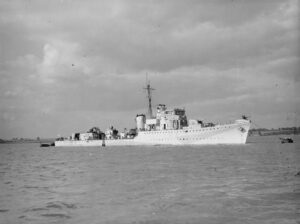 HMS Eglinton was ordered to Vickers-Armstrong, Tyne, laid down on 8 June 1939, launched on 28 December 1939 and completed on 28 August 1940. She saw action with the 16th Destroyer Flotilla at Harwich intil V-Day in 1945. She saw two naval actions with German S-Boats while escorting East coast convoys, especially around the time of D-Day. She was in the support force for the Normandy landings as well. When August 1945 came, she was decommissioned, placed in reserve at Harwich. This lasted until 24 June 1955, and then she was designated as a trials ship for Operation Sleeping Beauty testing the state of ships held in long reserve. There was a procedure set in place to bring her forward for service in the active fleet. Once the bogus reactivation task was achieved, she was put on the disposal list, sold for scrapping at Blyth, by Hughes Bolckow, 28 May 1956.
HMS Eglinton was ordered to Vickers-Armstrong, Tyne, laid down on 8 June 1939, launched on 28 December 1939 and completed on 28 August 1940. She saw action with the 16th Destroyer Flotilla at Harwich intil V-Day in 1945. She saw two naval actions with German S-Boats while escorting East coast convoys, especially around the time of D-Day. She was in the support force for the Normandy landings as well. When August 1945 came, she was decommissioned, placed in reserve at Harwich. This lasted until 24 June 1955, and then she was designated as a trials ship for Operation Sleeping Beauty testing the state of ships held in long reserve. There was a procedure set in place to bring her forward for service in the active fleet. Once the bogus reactivation task was achieved, she was put on the disposal list, sold for scrapping at Blyth, by Hughes Bolckow, 28 May 1956.
 HMS Exmoor
HMS Exmoor
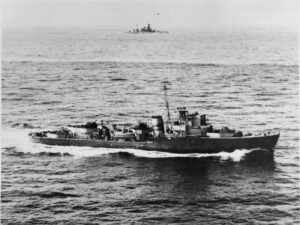 HMS Exmoor was built at Vickers-Armstrong on Tyne. She was laid down on 8 June 1939, launched on 25 January 1940 and completed on 1 November 1940. For the full logs. She was assigned to the 16th DF at Scapa Flow, Home Fleet from November. On the 6th, she was detached with HMS Pytchley to escort SS Adda to the Faeroe Islands, back on 11 November. In December she escorted AMCs Chitral and Salopian. After a refit at Plymouth by January 1941 she ecorted Queen Elizabeth from Portsmouth to Rosyth. Next, she joined the Harwich force for coastal convoys, North Sea (16th DDF) until February. On the 23th with Shearwater she escorted a convoy from the Thames to Methil when attacked by S-boats while off Lowestoft on 25th. She was hit by a tirpedo aft, with an explosion and major structural damage, rupturing a fuel supply line with a fire that spread rapidly. She capsized and sank in ten minutes, survivors picked by Shearwater and Commander Evans to Great Yarmouth. It was attributed to S30 (Klaus Feldt) or a mine (Admiralty claim).
HMS Exmoor was built at Vickers-Armstrong on Tyne. She was laid down on 8 June 1939, launched on 25 January 1940 and completed on 1 November 1940. For the full logs. She was assigned to the 16th DF at Scapa Flow, Home Fleet from November. On the 6th, she was detached with HMS Pytchley to escort SS Adda to the Faeroe Islands, back on 11 November. In December she escorted AMCs Chitral and Salopian. After a refit at Plymouth by January 1941 she ecorted Queen Elizabeth from Portsmouth to Rosyth. Next, she joined the Harwich force for coastal convoys, North Sea (16th DDF) until February. On the 23th with Shearwater she escorted a convoy from the Thames to Methil when attacked by S-boats while off Lowestoft on 25th. She was hit by a tirpedo aft, with an explosion and major structural damage, rupturing a fuel supply line with a fire that spread rapidly. She capsized and sank in ten minutes, survivors picked by Shearwater and Commander Evans to Great Yarmouth. It was attributed to S30 (Klaus Feldt) or a mine (Admiralty claim).
 HMS Fernie
HMS Fernie
HMS Fernie was laid down John Brown & Company, Clydebank on 8 June 1939, launched on 9 January 1940, and she was completed 29 May 1940. She completed working up in service, in the English Channel. She was an escort during the evacuation of troops from French Channel Ports, by June 1940. She was then in escort cover during a minelaying operation, the northern barrage, north of North Rona and returned in dull escort duties in the Channel. This went on in 1941-1942 with the North sea as well. In August 1942 she escorted the landing for of the abortive Dieppe Raid and went under heavy air attack. In 1943 Fshe returned in convoy defence in the North Sea and in 1944 covered the Allied landings in Normandy. She returned to thr same routine until August 1945, used as an air target ship at Rosyth. Next in reserve at Chatham until stricken, sold to BISCO, Port Glasgow 7 November 1956.
 HMS Garth (L20, 19
HMS Garth (L20, 19
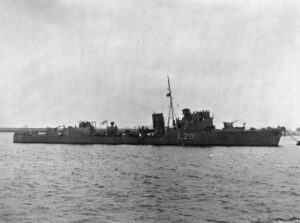 HMS Garth was ordered to John Brown & Company, laid down on 8 June 1939, launched on 14 February 1940 and completed on 1 July 1940. On commissioning she escorted ships in Home waters, Northwestern approaches and Channel and escorted HMS Erebus during the evacuation of Dunkirk. In November 1940 with HMS Campbell she sank S38 off Southwold. She remained escorting vessels on the East coast and in 1942 was nominated to provide cover for the Dieppe Raid, Operation Jubilee in August 1942. After this she resumed escorts in the Channel and North sea. In February 1943 she sank S73 off Yarmouth. In April 1944 she was selected to take part in D-Day. In October 1944 she brought naval gunfire for the Walcheren attack, Scheldt estuary and Antwerp. Then back to convoy escort, North Sea. In August 1945 she visited Rotterdam with Bellona, Onslow and Tuna as well as the other T class subs Dolfijn and Zeehond. Next she became an accommodation ship at Chatham, placed in reserve, sold to Thos. W. Ward, scrapped at Barrow on 25 August 1958.
HMS Garth was ordered to John Brown & Company, laid down on 8 June 1939, launched on 14 February 1940 and completed on 1 July 1940. On commissioning she escorted ships in Home waters, Northwestern approaches and Channel and escorted HMS Erebus during the evacuation of Dunkirk. In November 1940 with HMS Campbell she sank S38 off Southwold. She remained escorting vessels on the East coast and in 1942 was nominated to provide cover for the Dieppe Raid, Operation Jubilee in August 1942. After this she resumed escorts in the Channel and North sea. In February 1943 she sank S73 off Yarmouth. In April 1944 she was selected to take part in D-Day. In October 1944 she brought naval gunfire for the Walcheren attack, Scheldt estuary and Antwerp. Then back to convoy escort, North Sea. In August 1945 she visited Rotterdam with Bellona, Onslow and Tuna as well as the other T class subs Dolfijn and Zeehond. Next she became an accommodation ship at Chatham, placed in reserve, sold to Thos. W. Ward, scrapped at Barrow on 25 August 1958.
 HMS Hambledon
HMS Hambledon
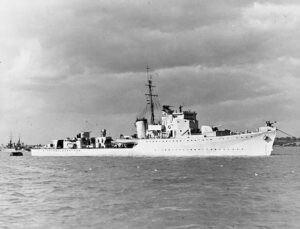 Hambledon was laid down at Swan Hunter, Wallsend on 8 June 1939, launched on 12 December 1939, completed 8 June 1940. Hambledon after trials in June proceeded to Portland and joined Atherstone, Fernie, Inglefield, and Imogen, escorting the 1st Minelaying Squadron for the Northern Barrage, north of North Rona (Operation SN1). On 12 July 1940 she was transferred to the Orkney Islands for wrking up her crew and based at Sheerness in July. On 31 August 1940 with Garth she was off the coast of the Netherlands, rescuing survivors of HMS Esk and assisted Express, loosing her bow in a mine explosion. By October she took part in Operation Lucid (destroying German invasion barges in ports). She hit an acoustic mine in the Channel off South Foreland and repaired at Sheerness and Chatham until May 1941.
Hambledon was laid down at Swan Hunter, Wallsend on 8 June 1939, launched on 12 December 1939, completed 8 June 1940. Hambledon after trials in June proceeded to Portland and joined Atherstone, Fernie, Inglefield, and Imogen, escorting the 1st Minelaying Squadron for the Northern Barrage, north of North Rona (Operation SN1). On 12 July 1940 she was transferred to the Orkney Islands for wrking up her crew and based at Sheerness in July. On 31 August 1940 with Garth she was off the coast of the Netherlands, rescuing survivors of HMS Esk and assisted Express, loosing her bow in a mine explosion. By October she took part in Operation Lucid (destroying German invasion barges in ports). She hit an acoustic mine in the Channel off South Foreland and repaired at Sheerness and Chatham until May 1941.
In May she started a serie of convoy escort/anti-invasion patrols in the North Sea (16th DF, Harwich, England) until October 1942. In November she was in North Atlanticescort convoys to Gibraltar for Operation Torch. By December she was back at Harwich. In 1943 she patrolled ahainst S-boats.
From June 1943 she was selected for Operation Husky, with the 58th Destroyer Division, transferred with HMS Uganda, destroyers and escort destroyers and Convoy WS 31/KMF 17 Clyde-Gibraltar. On 26 June she escorted KMF 17, in Gibraltar on 28 June. She was assigned Escort Group V, with Blankney, Blencathra, Brecon, Brissenden and Convoy KMF 18, from 7 July to Sicily, BARK WEST assault area, 10 July until the 31st reassigned to the 58th DD at Malta.
In August she carried no other than Fleet Adm. Andrew Cunningham for Operation Avalanche, at Salerno in September 1943. On 9 September she also hosted US Army General Dwight D. Eisenhower at Bizerta, and Malta to observe the surrender of the Italian fleet on 10 September. She returned to the Salerno landings with Cunningham on board.
In October she took part in Leros and Kos operation, Dodecanese Campaign. She resumed escort work in the central Mediterranean from November.
She operated next from Naples, patrolled the Italian west coast for more Allied operations. On 29 March she took part in the chase against U-223, detected by asdic in the Tyrrhenian Sea off Palermo. She was surfaced and destroyed by gunfore on 30 March.
In April she took part in Operation Neptune, naval phase of Overlord. From May 1944 she joined the 21st DF at Sheerness, joined escort assault Convoy G16, Force G, west Solent.
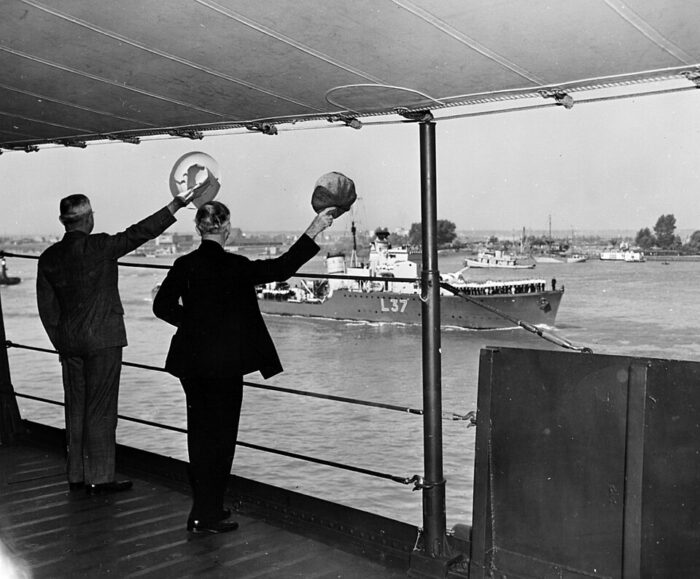
U.S. President Harry S. Truman and Secretary of State James F. Byrnes wave at HMS Hambledon while on board USS Augusta on the River Scheldt as they head to the Potsdam Conference on 15 July 1945
After the landings on 5-6 June and Convoy G16, Gold Beach she supporting the landing, shelling shore defences. Next she escorted Convoy EBP 2 with reinforcements and supplies and fought S-boats south of the Isle of Wight. On 7 June she was with the 112th Escort Group (frigates Spragge and Stockham, sloop Magpie) with escort EBP 2 to Utah Beach until 8 June and returned to S-Boote patrol. In July 1944 she was assigned to the 16th DF at Harwich, for convoy defence, North Sea and Channel until March 1945. She linked from there ports in Belgium and the Netherlands and Dover areas. In April back to the North Sea and Channel. On 12 April with the frigate Ekins she fought S-boats off Flushing. By May she was at the Nore Local Flotilla. In June-August she was in training duties or support for re-occupation forces. She was decommissioned, reserve by Decembe, Harwich Division until 1953, transferred to Barrow-in-Furness and in 1955 hulked, on the disposal list, sold August 1957 to BISCO, BU at Dunston-on-Tyne from September.
 HMS Holderness
HMS Holderness
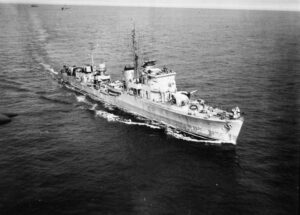 HMS Holderness was laid down at Swan Hunter, Wallsend on 29 June 1939, launched on 8 February 1940 and completed on 10 August 1940. She spent her career at the 21st Destroyer Flotilla, with the east coast convoys. On 10 March 1941 she shot down an enemy aircraft during an air attack. On 20 February 1942 she fought with German Schnellboote and sank one, taking 18 prisoners and its flag. She was adopted by Amman Valley, Wales during Warship Week 1942.
HMS Holderness was laid down at Swan Hunter, Wallsend on 29 June 1939, launched on 8 February 1940 and completed on 10 August 1940. She spent her career at the 21st Destroyer Flotilla, with the east coast convoys. On 10 March 1941 she shot down an enemy aircraft during an air attack. On 20 February 1942 she fought with German Schnellboote and sank one, taking 18 prisoners and its flag. She was adopted by Amman Valley, Wales during Warship Week 1942.
Battle honours: North Sea 1942–1945. After a postwar transfer to the Reserve Fleet at Harwich in 1946 she stayed there until stricke, on the disposal list, sold to Thos. W. Ward, BU in Preston from 20 November 1956.
 HMS Mendip
HMS Mendip
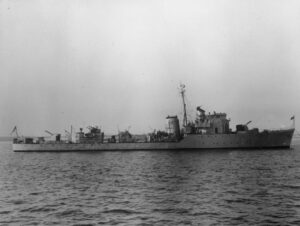 HMS Mendip was laid down at Swan Hunter, Wallsend on 10 August 1939, launched on 9 April 1940 and completed on 12 October 1940.
HMS Mendip was laid down at Swan Hunter, Wallsend on 10 August 1939, launched on 9 April 1940 and completed on 12 October 1940.
Mendip was assigned to the Home Fleet, Scapa Flow by October but was damaged when one one depth charges detonated in exercises. After repairs she resumed work up on 18 February 1941. On 30 March she joined the 21st DF at Sheerness, spent two years on convoy escort/patrol duties, North Sea and Channel and patroled against S-boats, but also rescued survivors, escorted minelaying operations. By September 1942 she was senior vessel at the 21 Flotilla under Captain (D) CR Parry. In June 1943 after refit she joined convoy WS31 for Operation Husky. In July she supported the invasion itself. In September she was at Operation Avalanche at Salerno and retrurned to convoy and patrol duties in the Mediterranean.
in May 1944 she was assignd to take part in Operation Neptune, 21 DF, local escort duties until VE Day, May 1945.
Last action was Operation Deadlight, the disposal of the German U-boat fleet. In January 1946 she was paid off in Reserve until 20 May, sold to Nationalist China in 1947 as Lin Fu. Seized prior to delivery, re-sold 1949 to Egypt as Mohamed Ali el Kebir, then Ibrahim el Awal in 1951, captured by Israel on 31 October 1956, recommissioned as INS Haifa (K-38), decommissioned 1968, sunk as target by a Gabriel missile.
 HMS Meynell
HMS Meynell
HMS Meynell was laid down at Swan Hunter, Wallsend o, 10 August 1939, launched on 7 June 1940 and completed on 30 December 1940. Aircraft target ship 11 September 1945 to December 1946, when paid off. Sold to Ecuador 1954 and renamed Presidente Velasco Ibarra. 05/05/1978: Stricken and broken up. To be completed in a later update.
 HMS Pytchley
HMS Pytchley
HMS Pytchley was built at Scotts, Greenock, laid down on 26 July 1939, launched on 13 February 1940 and ccmpleted on 23 October 1940. She was paid off August 1946 and broken up 1 December 1956. To be completed in a later update.
 HMS Quantock
HMS Quantock
HMS Quantock was built at Scotts, Greenock, laid down on 26 July 1939, launched on 22 April 1940 and completed on 6 February 1941. She was Paid off December 1945. Sold to Ecuador 1954 and renamed Presidente Alfaro. To be completed in a later update.
 HMS Quorn
HMS Quorn
HMS Quorn was ordered to J. Samuel White in Cowes, she was laid down on 26 July 1939 and launched on 27 March 1940 and completed on 21 September 1940. She was sunk by a human torpedo off the Normandy beaches during the D-Day invasion, 2 August 1944. To be completed in a later update.
 HMS Southdown
HMS Southdown
HMS Southdown was started at J. Samuel White, Cowes, laid down on 22 August 1939. She was launched on 5 July 1940 and completed on 8 November 1940.
Fate: Aircraft target ship 8 September 1945 to 1946. Paid off 22 May 1946, and broken up 1 November 1956. To be completed in a later update.
 HMS Tynedale
HMS Tynedale
HMS Tynedale was orderd to Stephens, Linthouse, laid down on 27 July 1939, launched on 5 June 1940 and completed on 2 December 1940.
She was sunk by the German submarine U-593 on 12 December 1943. To be completed in a later update.
 HMS Whaddon
HMS Whaddon
HMS Whaddon was built at Stephens, Linthouse, Laid down on 27 July 1939, launched on 16 July 1940 and completed on 28 February 1941.
She was paid off October 1945 and broken up 5 April 1959. To be completed in a later update.
Read More/Src
Books
HMS Badsworth: The British Hunt-class Escort Destroyer, Waldemar Góralski – Topdrawings Nr. 69 (Kagero pub)
Brown, D. K. Nelson to Vanguard, Chatham Publishing, 2000
Cocker, Maurice. Destroyers of the Royal Navy, 1893–1981, Ian Allan
Colledge, J. J.; Warlow, Ben (2006) [1969]. Ships of the Royal Navy: The Complete Record of all Fighting Ships of the Royal Navy (Rev. ed.). London: Chatham Publishing.
English, John. The Hunts: A History of the Design, Development and Careers of the 86 Destroyers of This Class Built for the Royal and Allied Navies During World War II, World Ship Society, 1987
Gardiner, Robert (ed.) Conway’s All the World’s Fighting Ships 1922–1946, Naval Institute Press
Ireland, Bernard (2003). Battle of the Atlantic. Barnsley: Naval Institute Press.
Lenton, H. T. British and Empire Warships of the Second World War, Greenhill Books
Marriott, Leo. Royal Navy Destroyers Since 1945, Ian Allan
M. J. Whitley, Destroyers of World War Two: An International Encyclopaedia, Arms and Armour Press, 1999
Brown, David (1995) [1990]. Warship Losses of World War Two (2nd rev. ed.). London: Arms and Armour Press.
Links
naval-history.net
navypedia.org/
coatneyhistory.com Hunts.htm
uboat.net
en.wikipedia.org
commons.wikimedia.org
3D
https://embed-3dwarehouse-classic.sketchup.com/model/99869266-4ec2-4681-a936-25ea6c13d0b6/HMS-Badsworth-British-escort-destroyerType-II-Hunt-class1942
Video
Hunt class by Drachinifels
Hunt class by Dr. Alex
Model Kits
https://modelshipworld.com/topic/29244-orp-kujawiak-1942-by-king-derelict-finished-ibg-1700-plastic-hunt-class-destroyer/
scalemates.com ibg-models hms-zetland 1942 hunt-ii
all kits on scalemates.com/
https://www.britmodeller.com/forums/index.php?/topic/235023524-hunt-class-type-2/

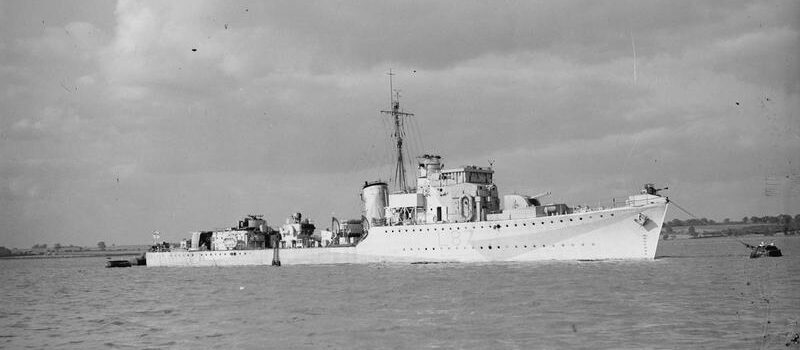
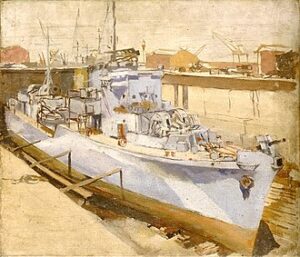
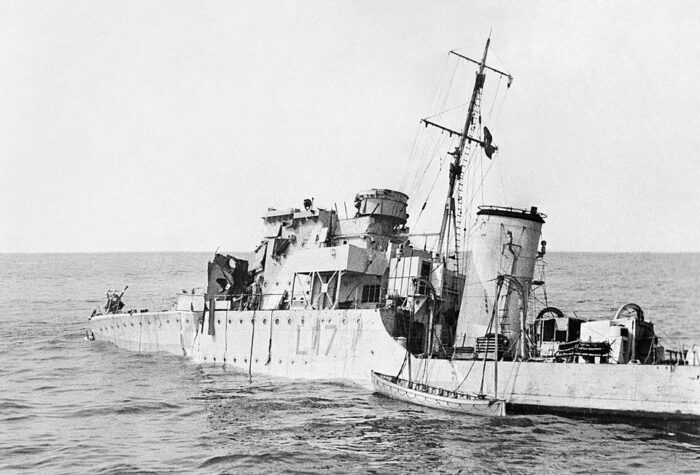
 Latest Facebook Entry -
Latest Facebook Entry -  X(Tweeter) Naval Encyclopedia's deck archive
X(Tweeter) Naval Encyclopedia's deck archive Instagram (@navalencyc)
Instagram (@navalencyc)





 French Navy
French Navy Royal Navy
Royal Navy Russian Navy
Russian Navy Armada Espanola
Armada Espanola Austrian Navy
Austrian Navy K.u.K. Kriegsmarine
K.u.K. Kriegsmarine Dansk Marine
Dansk Marine Nautiko Hellenon
Nautiko Hellenon Koninklije Marine 1870
Koninklije Marine 1870 Marinha do Brasil
Marinha do Brasil Osmanlı Donanması
Osmanlı Donanması Marina Do Peru
Marina Do Peru Marinha do Portugal
Marinha do Portugal Regia Marina 1870
Regia Marina 1870 Nihhon Kaigun 1870
Nihhon Kaigun 1870 Preußische Marine 1870
Preußische Marine 1870 Russkiy Flot 1870
Russkiy Flot 1870 Svenska marinen
Svenska marinen Søværnet
Søværnet Union Navy
Union Navy Confederate Navy
Confederate Navy Armada de Argentina
Armada de Argentina Imperial Chinese Navy
Imperial Chinese Navy Marinha do Portugal
Marinha do Portugal Mexico
Mexico Kaiserliche Marine
Kaiserliche Marine 1898 US Navy
1898 US Navy Sovietskiy Flot
Sovietskiy Flot Royal Canadian Navy
Royal Canadian Navy Royal Australian Navy
Royal Australian Navy RNZN Fleet
RNZN Fleet Chinese Navy 1937
Chinese Navy 1937 Kriegsmarine
Kriegsmarine Chilean Navy
Chilean Navy Danish Navy
Danish Navy Finnish Navy
Finnish Navy Hellenic Navy
Hellenic Navy Polish Navy
Polish Navy Romanian Navy
Romanian Navy Turkish Navy
Turkish Navy Royal Yugoslav Navy
Royal Yugoslav Navy Royal Thai Navy
Royal Thai Navy Minor Navies
Minor Navies Albania
Albania Austria
Austria Belgium
Belgium Columbia
Columbia Costa Rica
Costa Rica Cuba
Cuba Czechoslovakia
Czechoslovakia Dominican Republic
Dominican Republic Haiti
Haiti Hungary
Hungary Honduras
Honduras Estonia
Estonia Iceland
Iceland Eire
Eire Equador
Equador Iran
Iran Iraq
Iraq Latvia
Latvia Liberia
Liberia Lithuania
Lithuania Mandchukuo
Mandchukuo Morocco
Morocco Nicaragua
Nicaragua Persia
Persia San Salvador
San Salvador Sarawak
Sarawak Uruguay
Uruguay Venezuela
Venezuela Zanzibar
Zanzibar Warsaw Pact Navies
Warsaw Pact Navies Bulgaria
Bulgaria Hungary
Hungary

 Bundesmarine
Bundesmarine Dutch Navy
Dutch Navy Hellenic Navy
Hellenic Navy Marina Militare
Marina Militare Yugoslav Navy
Yugoslav Navy Chinese Navy
Chinese Navy Indian Navy
Indian Navy Indonesian Navy
Indonesian Navy JMSDF
JMSDF North Korean Navy
North Korean Navy Pakistani Navy
Pakistani Navy Philippines Navy
Philippines Navy ROKN
ROKN Rep. of Singapore Navy
Rep. of Singapore Navy Taiwanese Navy
Taiwanese Navy IDF Navy
IDF Navy Saudi Navy
Saudi Navy Royal New Zealand Navy
Royal New Zealand Navy Egyptian Navy
Egyptian Navy South African Navy
South African Navy






























 Ukrainian Navy
Ukrainian Navy dbodesign
dbodesign